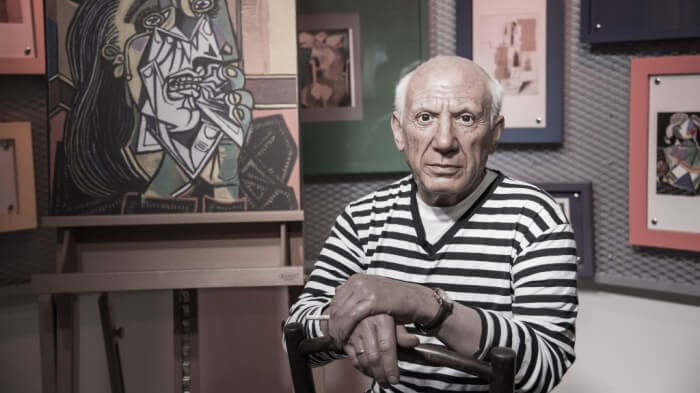Why Creatives Must Not Leave Traditional Business Skills At The Door
Creatives shouldn't turn their noses up at the material value of their creations.

"Being good in business is the most fascinating kind of art. Making money is art and working is art and good business is the best art." Andy Warhol summed it up perfectly and yet for many, the business of creativity, that moment where the creative product equates to a monetary value, is problematic.
It’s not that we want to live the life of an impoverished artist, it’s just that often, we’re just not very good at the business side of things. So why is this?
Show me the money
First of all, we need to make sure that we get paid for producing the work that we are so passionate about. We need to put a value on our product - whether it’s an item of clothing, an advert, a piece of art or craft, or software. If we acknowledge its value, it is more than likely that others will too.
A potential customer, visiting Pablo Picasso’s studio was reported to have stood in front of a painting for some time before asking “So what does it represent?” Without hesitation, Picasso was said to have replied “Two hundred thousand dollars.”
Be competitive with your price. Look at what others are charging for similar products and decide where you want to fall within that price range. Assess the significance, originality and quality of your product in comparison to what else is on offer and make sure that your prices fall within the means of your target audience.
If you are more expensive than your competitors, what will you provide that justifies the extra cost. Assess the market. Be confident about the price you set. Be like Picasso.
Intellectual Property
"Intellectual Property is the oil of the 21st century." - Mark Getty, co-founder of Getty Images.
The creative industries depend on the trading of their output, which is often not tangible. How do we stop others making money from our intellectual property? Take the case of a friend who, upon hearing the lyrics that she wrote receiving airplay on the radio, was able to prove that she was the author and receive the money that she was owed, because she understood intellectual property laws.
Within the creative industries, there are various ways to protect your output and each of these methods will depend upon the exact sector that you work in. Get educated. Find out what protection you need and implement it.
Some intellectual property is protected automatically, such as literary works, art, photography, music, web and films. Others, you have to apply for, such as product names, logos, jingles, packaging and inventions.
Don’t talk about your ideas until you have them registered, and if you do, have the other party sign a non-disclosure agreement. Take your intellectual property seriously and never sign away all of your rights.
Stand out from the competition
With the best products in the world, there are no sales without marketing. Fortunately, for those just starting out, marketing doesn’t have to drain the budget and there are many ways to get your product or brand noticed with little or no outlay.
Social media has changed the way we connect to our audience.
When Burberry announced that Brooklyn Beckham, the 16 year old son of David & Victoria Beckham would be the photographer for their latest fragrance advertising campaign, the art world was outraged, and yet Burberry understood that with 5.9 million Instagram followers, they could capitalise on Brooklyn Beckham’s connection with his audience, rather than his experience in the industry.
So if you’re not the son of a celebrity couple how do you stand out in a market that is already saturated? Understand who you are, and what you stand for. Your audience want to feel like they know you and align with your voice - being consistent can help with this.
Another way of expanding your audience is by collaborating with others.
Meeting the brief and delivering to deadlines
“Most artists have experienced the creative block. We get stuck in our work. We beat our head against the wall: nothing. Sometimes, it is because we are trying something at the wrong time.” - Lukas Foss.
Working to a brief or deadline can be especially difficult for some creatives and this can be further exacerbated by the onset of creative block. When there’s a project to complete, and no ideas are forthcoming, or those that do, do not seem feasible, what can you do?
There are a variety of suggestions freely available online to overcome this uneasy situation ranging from stepping away from the project and changing your environment, to taking some exercise (in whatever form that comes) to referring back to that notebook that you carry with you constantly to jot down your ideas.
Find a strategy that works best for you, and use it. Creativity cannot always be forced, and unlike solving a maths equation, cannot always be attempted. This is why we often find ourselves working late into the night, although this in itself can be a strategy for achieving some of your best ideas.
Art was once championed as some kind of divine activity that should not be tainted in the pursuit of financial reward. As creatives, and for all those in the business of creativity, this legacy still weighs heavy on us at times, but with the right skills and understanding of the business-side of things, creativity really can pay off.
Ann Healey is a practising artist and lecturer on GSM London's Business Management with Creative Industries programme.
Thanks for signing up to Minutehack alerts.
Brilliant editorials heading your way soon.
Okay, Thanks!




